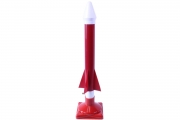
|
SCE-117760
Rocket -Air Powered Projectile$76.00
Rocket -Air Powered Projectile. This air-powered projectile is sure to send your students' imaginations soaring.Solid-fuel and water rockets just have too many variables for accurate study of Newton's Laws. So explore projectile motion with this 100% safe, chemical-free air-powered projectile. Accurate and repeatable to an amazing degree, thanks to the hard-plastic chassis, this missile flies straight and true with minimal wind effect. Since it takes off at the same velocity every time, your outcome is always precise and consistent - important for students testing predictions, who'll reap rewarding results. And it's a breeze to use. All you do is pressurize the launch chamber with an ordinary bicycle pump. When the pressure is high enough to pop off the thrust washer, the projectile blasts into the sky. Each projectile comes with four different thrust washers - Low, Medium, High, and Super - so you can vary launch speed for different experiments. You can even build a launch pad (or use the one below) to vary launch angles. Then your students can use Newton's Laws to predict where the projectile will land! P4-2200 Air-Powered Projectile includes red launcher base with white pressure tube, rocket body with nose cone, and set of 4 washers. The Launch Pad and Angled Wooden Wedges pictured are sold separately. Cool Computer SimulationTry an Interactive Physics Software simulation on Projectile Motion! Here's a lesson you can try with the air-powered projectile:
Vy = 30 m/s (sin 60°) = 26 m/s vertical velocity
|




